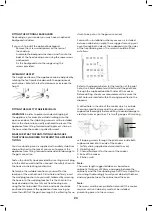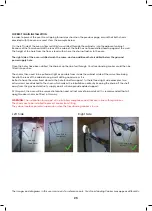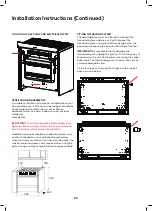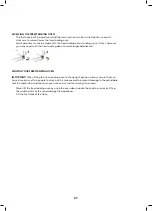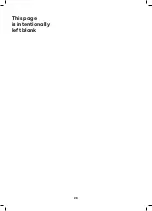
13
Baking
•
For best results when baking, always preheat your
oven to the desired temperature. The temperature
indicator light will switch off to indicate that the set
temperature has been reached.
•
We advise you do not open the door until at least ¾
of the way through cooking.
•
Make sure cake pans do not touch each other or the
sides of the oven.
•
If you are doubling the baking recipe (especially
cookies), the cooking duration may need to increase.
•
Your cookware will significantly influence baking
times. Dark pans absorb the heat more quickly than
reflective pans; glass cookware may require a lower
temperature.
•
Where you are baking using multiple shelves, you
may require a slight increase in cooking time.
Shelf Position Guide
•
Single shelf: place your baking on a wire rack that will
have the top of your pan near the center of the oven
cavity, for optimum results.
•
Multiple shelves: always leave a space between
shelves to allow the air to circulate.
Roasting
•
The Roast (or Fan + Grill) function is designed to
brown the outside of the meat but still keep the inside
moist and juicy.
•
Boneless, rolled or stuffed roasts take longer than
roasts containing bones.
•
Poultry should be well cooked with the juices running
clear and an internal temperature of 74°C.
•
If using a roasting bag, do not use the Roast function.
The initial searing stage is too hot for roasting
bags. Use Fan Bake or Fan Forced and follow the
manufacturer’s instructions.
•
When using the Roast function, do not cover your
roast, as this will stop the searing process browning
the outside of the meat. If you prefer to roast in a
covered pan, use the Fan Bake function instead and
increase the temperature by 20°C.
•
Cook larger cuts of meat at a lower temperature for a
longer time. The meat will cook more evenly.
•
Always roast meat fat side up. That way, basting may
not be required.
•
Always rest the meat for at least 10 minutes after
roasting to allow the juices to settle.
•
Remember the meat will continue to cook for a few
minutes after removing it from the oven.
Shelf Position Guide
•
Place the meat on a shelf so that it is in the center
of the oven or lower.
Grilling
•
This is a healthier alternative to frying.
•
Always grill with the oven door completely shut.
•
For best results allow 5 minutes of preheat before
placing food in the oven.
•
If you use glass or ceramic pans, be sure they can
withstand the high temperatures of the grill.
•
To avoid piercing the meat and letting juices escape,
use tongs or a spatula to turn the meat halfway
through cooking.
•
Brush meat with a little oil to help keep the meat
moist during cooking. Alternatively marinade
the meat before grilling (but be aware that some
marinades may burn easily).
•
Where possible grill cuts of meat of a similar thickness
at the same time. This will ensure even cooking.
•
Always keep a close watch on your food while grilling
to avoid charring or burning.
Shelf Position Guide
•
For thinner cuts of meat, toasting or browning foods,
use a higher shelf position.
•
Thicker cuts of meats should be grilled on lower
shelves or at a lower grill setting to ensure even
cooking.
Reheating food
•
Use Bake or Fan Bake to reheat food.
•
Bake and Fan Bake are particularly good for
reheating pastry based items, as the base heat will
help re-crisp the pastry case.
•
Always reheat food to piping hot. This reduces the risk
of contamination by harmful bacteria.
•
Once hot, set the oven temperature to WARM or use
the warming drawer to keep food hot.
•
Never reheat food more than once.
Cooking Guidelines























